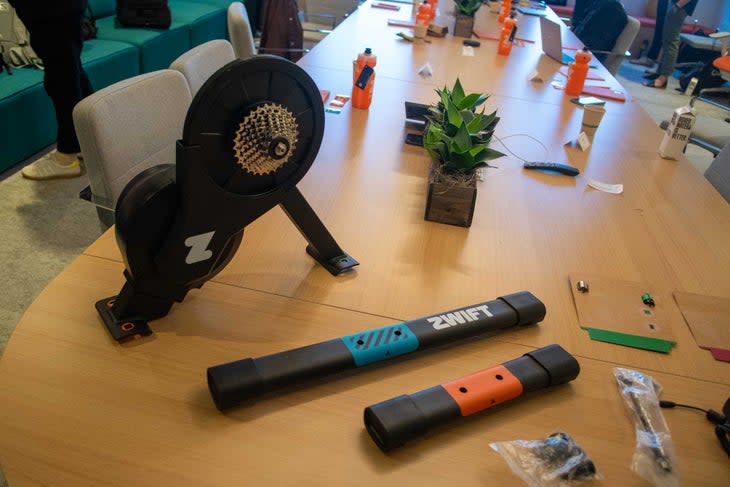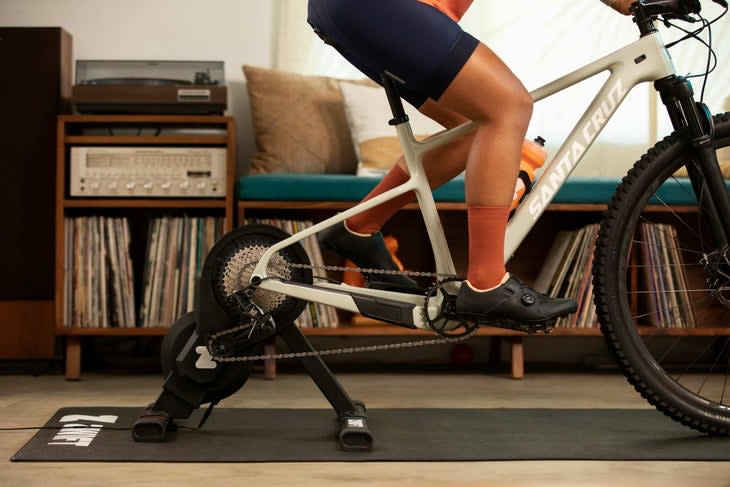Zwift enters the hardware market with the seriously enticing $499 Zwift Hub direct drive trainer
This article originally appeared on Velo News
Getting started on Zwift is about to become easier and cheaper.
Known for its popular immersive virtual training software, Zwift is now entering the hardware space with an extremely enticing first offer: a $499 direct drive trainer called Zwift Hub.
At this point, Zwift is so well known amongst core cyclists and triathletes that it's used as a verb. Increasingly however, the company says, people are coming to the platform who identify as beginners, or are even getting in to cycling through Zwift. And with that means less familiarity with the equipment needed just to get started, as well as more hesitancy about buying that often expensive equipment.
"We wanted to remove friction to make [the Hub trainer] the easiest, most accessible way to get on Zwift," said Zwift VP of content, Mark Cote.
Also read: Change is on the horizon in Watopia: Zwift announces a batch of updates through 2022
To that end, Zwift Hub is essentially Zwift in a box. It comes with everything a prospective Zwift user needs to get started, minus the bicycle -- and with its $499 price point, it's something that will catch the eye of both newcomers and seasoned cyclists.

For comparison, a Wahoo KICKR retails for $1,200, while the cheaper KICKR CORE is still $900 and a Saris H3 costs $800.
Zwift Hub ships with a cassette pre-installed, and fits eight to 12 speed cassettes as of now. Customers get to choose which size they want at checkout (8-11 speed options have a 11-28T range while the 12 speed is 11-30T).
There are only a few steps involved in assembling the trainer. Join the color-coded base pieces (which are also graphically differentiated for color-blind people) to the trainer, plug it in, and you're on your way.
The most difficult part about assembly might be choosing the right end caps to fit a given bike's dropout length. But Zwift has made this process somewhat less fraught (though likely not foolproof) by including cards with pre-measured dropout distances.

The trainer
If the Zwift Hub looks familiar, it's probably because it is. Zwift has contracted with JetBlack to build the trainers, and both in terms of features and looks Zwift's model shares many similarities to that brand's Volt smart trainer.
The Hub is not a carbon copy of that trainer however. Zwift notes a few changes between them including a change in the Bluetooth cap location, and that the Hub is only being sold in the EU, UK, and US.
Also read: You can now race yourself on Zwift with Holographic Replay
The specs
By now you're probably wondering where the catch is with this $499 price point. It has to be hidden in the spec sheet, right?
From what I can tell, there doesn't appear to have been much in the way of compromises made to make the Hub. It features +/- 2.5% accuracy (a little lower than other top trainers but not enough for most riders to care), a max power of 1,800 watts and the ability to simulate up to 16% gradients. Those are also the same specs as the JetBlack Volt, a trainer with a suggested price tag of $1,200.
The Hub weighs 15kg including a 4.7kg flywheel, and it can handle up to a 130 kg (254 lbs) rider.

And when it comes to compatibility with devices, it has both Bluetooth and ANT+ connectivity. There isn't any form of locking the hardware to Zwift either. The trainer is free to be used on any other platform or service -- or on its own without any accompanying software.
Zwift also has said that the trainer is not a loss-leader -- something to get customers in the door and set up on the platform at a loss, with hardware losses eventually recouped through the $15 monthly software subscription. The brand says that it is in fact making a profit even with this $499 price point.
Also read: From Zwift Academy to Vuelta a Espana glory: Jay Vine's incredible WorldTour journey
Going the distance
Zwift has been testing the Hub to make sure it stands up to years of hard use.
There are currently four trainers hooked up to test machines that are constantly running to test durability. The machines are approaching two years of simulated hard usage based on a real Zwift rider’s annual 250 hours of riding and each trainer is holding up fine so far.

Zwift also created a dream job for this project as well. To ensure that the Hub stands up to everything a real Zwift user might try, Zwift has hired quality assurance riders whose job it is to ride the trainer all day on a variety of training plans. The testers have put in over 10,000 miles so far. Getting paid to Zwift doesn't sound so bad.
Also read: Zwift CEO: Tour de France Femmes 'exceeded everyone's expectations'
Compatibility
Zwift has also been busy testing the Hub trainer with a variety of bike models, and importantly across a variety of frame sizes from 45cm to 64cm as well as drivetrains, including 8 to 12 speed groups. The company has tested 500 so far, and the vast majority have fit just fine. Zwift will be sharing this ever growing list of compatible frames on its website.

Availability
The Hub trainer will be available October 3 exclusively on zwift.com.
For exclusive access to all of our fitness, gear, adventure, and travel stories, plus discounts on trips, events, and gear, sign up for Outside+ today.

